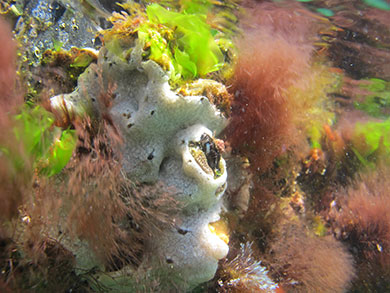The marine pest, Didemnum perlucidum, also known as the white colonial sea squirt, is now widely established in many ports, marinas and other locations in Western Australia.
Its establishment serves as a cautionary tale of what can happen if a pest is not detected or recognised, nor attempts made to eradicate it at an early stage, and highlights the importance of prevention and early detection which increases the chances of a timely response and successful eradication.
Background
In 2010 D. perlucidum was found for the first time in Western Australia. During routine introduced marine pest monitoring along the WA coast in 2011-2012, we confirmed additional disjunct populations in a span of about 2,800 km along the coast.
Due to the widespread distribution eradication was unlikely, but implementing local control measures to protect high value areas, such as marine parks or protected areas, from incursions was thought to be feasible.

Didemnum perlucidum is the white sea squirt attached to the rock.
Abrolhos trials
In February 2015, D. perlucidum was identified on a number of pearling lines and moorings at the Abrolhos Islands. In response, we started trialling control methods in October 2015 to remove this pest within the Easter Group of islands.
Unfortunately, D. perlucidum was not eradicated despite a follow-up trial, which was ended due to very heavy re-infection of treated infrastructure from newly discovered pearling lines, and lines below the safe diving depth of 30 metres.
We are now managing this pest species only in high value asset areas, such as State marine parks, A-class reserves, lands and waters adjacent to A-class reserves, and pearling and aquaculture facilities.
Our current management response
The Department is now focused on only managing D. perlucidum at the Montebello Islands where it is not known to be established and is a noxious-listed pest.
Vessel skippers travelling to this location are required to follow the Department’s vessel management recommendations (see below). Any sightings of this pest at the Montebello Islands should be reported to our FISHWATCH 24-hour hotline on 1800 815 507.
Good vessel management prevents the spread of marine pests
To help prevent the spread of marine pests to our aquatic environment, vessel owners bringing vessels into WA waters are urged to follow the Department’s advice which includes keeping hull fouling to a minimum, checking for pests on vessels before travelling, and making sure antifouling paint is suitable and renewed regularly
Vessel skippers who bring marine pests into WA waters may be in breach of the Fish Resources Management Act 1994 and regulations made under the Act.
For further information see the Department’s  CLEAN vessel policy, Vessel Check tool and relevant policies.
CLEAN vessel policy, Vessel Check tool and relevant policies.
Further information
 Potential eradication and control methods for the management of the ascidian Didemnum perlucidum in Western Australia.
Potential eradication and control methods for the management of the ascidian Didemnum perlucidum in Western Australia.
Additional information can be found in research articles by Munoz et al (2015) Aspects of reproductive ecology of the introduced ascidian Didemnum perucidum, and Bridgwood et al (2014) Catch me if you can! The story of a colonial ascidian’s takeover bid in Western Australia.